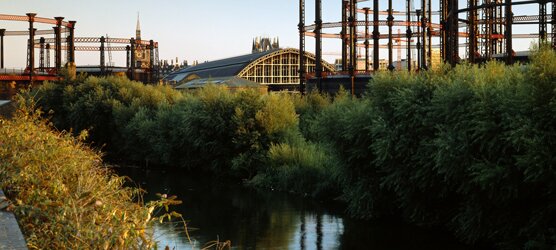Transport

English Heritage has always been involved in highways and transport matters because they frequently have significant impacts on the historic environment. English Heritage has had greatest involvement in new road proposals and major upgrading activities, but also comments on strategy documents, appraisal systems and policy issues. Other forms of transport, including tram and light transit systems, railways and canals also feature in our work.
New developments are likely to have the greatest impact on the historic environment, but the existing transport network can have an impact particularly where there are high levels of congestion which can intrude visually and aurally on historic areas. Small developments may have a cumulative impact, either permanently (such as piecemeal dualling of trunk roads) or in ways that may be reversed (such as the accumulation of signs and other street clutter in historic areas).
Local authorities are key deliverers of transport and transport policy. In addition to the statutory environmental appraisal of local transport plans and schemes, local authorities can contribute to enhancing the quality of the local historic environment, for example by improving the streetscape, reducing congestion, or developing innovative transport plans that avoid the need for new and potentially damaging infrastructure.
Streets for All
English Heritage's Save our Streets campaign, in conjunction with the Women’s Institute, highlighted the detrimental impact of excessive numbers of signs, guardrails and other clutter on our streets. In 2005 Streets for All: guidance for practitioners was produced by English Heritage, in conjunction with the Department for Transport, and in 2008 English Heritage published 10 Streets For All: Practical Case Studies. These showcase the best ‘how to’ examples of councils which have taken the initiative to deal with a particular aspect of street clutter.
Ports
This policy statement, published in May 2006, is intended to inform developers and others about the importance and relevance of the historic environment and how it must be taken into account in development proposals affecting ports. The focus of the document is mainly on the marine aspect of new developments but it also touches on the development of existing ports and the additional, inland, impacts of development.
Policy on national or strategic transport issues is led by English Heritage's Policy Team. For information on specific transport schemes, please contact the relevant regional office.
What's New?
-
Britain was the world’s first industrial nation and has a wealth of industrial heritage but many industrial sites have been lost or are at risk due to functional redundancy. English Heritage's survey has shown that the percentage of listed industrial buildings at risk is three times greater than the national average for listed buildings at risk.
-
The value of a well managed, protected and appreciated historic environment to both our quality of life and to the economy is well established. Heritage tourism contributes £20.6 billion to GDP a year whilst research shows that 93% of people think that in improving their local place it is important to save heritage assets.
